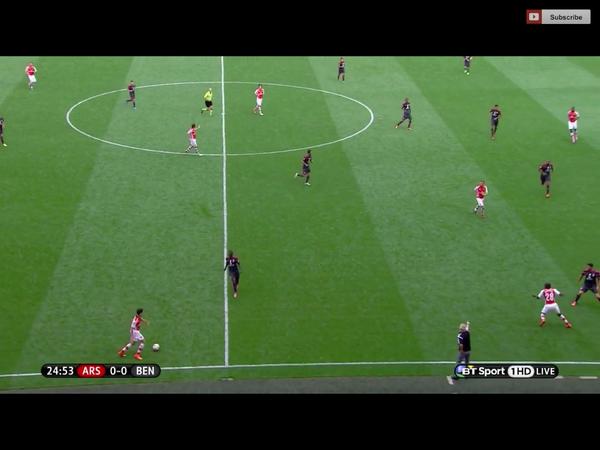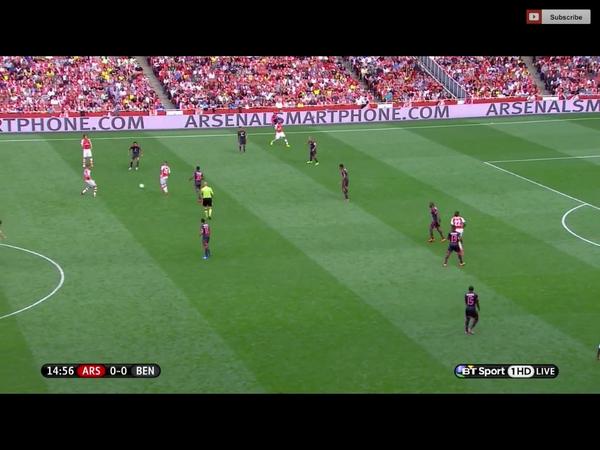The Tactics Column returns for a new season, appearing on a fortnightly basis throughout this new campaign. Tonight, Anam looks at how we’ve been shaping up ahead of Saturday’s kick-off.
—
Midfield variation
An underrated part of Arsene Wenger’s game-management last season was how he subtly altered Arsenal’s midfield shape depending on the situation. For example, in the crucial period of the season where The Gunners faced Tottenham, Chelsea and Bayern Munich for example, Wenger went with a 4-3-3 (or 4-1-4-1). He did this earlier in the season too, notably against Chelsea while sometimes even pushing Mesut Ozil up almost as the second striker. He’ll be without Ozil, however, for the start of this season and as such, Wenger has chosen not to play with a no.10, but use instead two box-to-box midfielders in front of Mikel Arteta.
Inverting the triangle in such a way works best for the two midfielders who have mainly played in those roles in pre-season: Aaron Ramsey and Jack Wilshere. In simple terms, it suits them because both are still developing, yet the tactical ramifications might actually serve the team better as a whole too.
First up; the big games. Arsenal’s problems stemmed from conceding too early (then capitulating badly) by constantly giving the ball away. This 1-2 shape in the midfield gives a sensible base to build on, allows Arteta not to be isolated, and if Arsenal lose the ball, they should then have cover to defend the sides. For Wilshere, who’s fantastic in transitions, turning defence to attack, as we saw in the 3-0 Community Shield win against Man City, this role should suit him perfectly. With his pinpoint passing, starting 10m or so deeper creates a natural vantage point to spray passes to the wide forwards, something which is sure to become a key feature of Arsenal’s play in 2014/15.
Then there’s the man-of-the-moment, Aaron Ramsey, who can profit most from the extra freedom to break forward. Last season, he caught the eye with his ability to get into the box but as impressive as his stamina was just how clever his running has become. Ramsey is fantastic at moving wide to create an overload, as the graphic below shows when he set up Yaya Sanogo against Benfica by driving to the right-hand side to support Hector Bellerin in possession, or by bursting beyond the first line of press so that the defence can easily bring it out. In short, he’s the all-action that more and more teams have nowadays.

That’s not to say there’s no space for number 10s. When Ozil returns, it’s likely that the shape will return to a 4-2-3-1. That’s okay as top teams must have all sorts of variations and adapt as the match and situation demands. Certainly, at times last season, Ozil was even asked to play deeper and in pre-season, we’ve seen Rosicky in such a role, dropping back and attracting defenders to him thus creating space for Ramsey to burst forward. Fluidity, though, is best when it happens naturally, and with the confidence gained from winning trophies, we can hope to see an evolved system this year.
Where Alexis will fit
It seems that Wenger isn’t yet entirely decided on where Alexis Sanchez will play. Most recently, he has said that Alexis can “play on both flanks”, seemingly ruling him out of the running to play as a number 9 in the short-term. Much of that, however, seems to be down to the form of Yaya Sanogo more than the relative suitability of Alexis up front. Sanogo, in the last year, has been a revelation, a gangly but mobile striker who can offer all that Arsenal need up front. His four goals against Benfica showcased what he brings, finishing in typically poacherish style but doing the things all top strikers must be able to do nowadays: drop-off to bring others into play, spray passes to the flanks and then pose a threat on the shoulder of the last defender.
As Joachim Low said during the World Cup; “players must be mobile nowadays. Static strikers do not exist anymore.” That seemingly spells bad news for Olivier Giroud who lacks that filibustering quality typically known in the English football lexicon as just “running around a bit.” Certainly, Sanogo’s impact puts his place under pressure but it’s likely the pair will rotate for positions, and not initially Alexis, because Wenger likes to augment his sides’ technical style with a target-man striker who makes those passes stick.
Alexis’s strength, though, is that he can fit anywhere. In the Community Shield win, he tended to roam inside and use his creative abilities rather than his dribbling to bring others into play. Indeed, that’s probably one of the biggest misconceptions about his play; Alexis is not chiefly a dribbler although protecting the ball, then twisting and turning away from markers is one of his strengths. Rather, he’s a deadly off-the-ball runner, over longer distances, who can get away from tight situations if need be. That’s why he might be best suited to playing up front eventually for Arsenal. In any case, the extra space in the Premier League should see him revel. At times at Barcelona, because opposition defences were often set, his role was seemingly reduced to a ferreter and furrower, running up and down the flanks as if seeing the pitch as elaborate tunnels, rather than the creative force he has been throughout his career. Playing for Arsenal should make him breathe easily again.
Pass to Debuchy on the right-hand side
Footballers are not meant to say anything profound on social media. Sure, there might be the odd unfortunate tweet, but otherwise, the club’s PR team pretty much has them dulled. Which is why, when Theo Walcott tweeted to welcome Mathieu Debuchy to the club, you’d be forgiven for treating it as innocuous. However, Walcott hit the nail on the head when he tweeted: “Looking forward to the link up play with @MatDebuchy #WelcomeDebuchy #AFC #COYG”
It’s a crucial point because in the last two seasons, the partnership between Walcott and Bacary Sagna was a key feature of Arsenal’s play – 37% of Arsenal’s attacks came from that side. That means when Debuchy plays there he has immense responsibility in starting Arsenal’s attacks and maintaining the curious (im)balance that the team has. We saw the beginnings of that dynamic in the Community Shield where Debuchy played with Alexis and he was aggressive in getting forward. 39% of attacks originated from the side as Arsenal dominated the first-half. He wasn’t so much the outlet that Sagna was as Arsenal used to purposely target him in the build-up and goal-kicks; instead he looked to burst up field to create width in attacks. There was a partnership of sorts forming between Debuchy and Alexis, with the Chilean cutting inside due to the right-back’s aggressive positioning. Debuchy was also tenacious in defence and that intensity should serve Arsenal well when the season kicks off. “I think Debuchy is very good going forward, he’s very quick in transition,” says Wenger. “He’s sharp in his marking, good with interceptions and quick to go from defence to attack. You feel he always has the desire to go forward. I believe he will be perfectly suited to our style.”
On the other side, there’s an absence of such an obvious partnership. Wenger likes to play Santi Cazorla on the left, and by roaming inside, there’s often not an outlet for Kieran Gibbs when he receives the ball. Instead, he almost always opts to pass inside early in the build up. Then there’s Mikel Arteta, the man who usually orchestrates attacks. His preferred habit is to pick up the ball facing the play and as such, his body shape tends to be facing the right hand-side therefore passes will invariably go towards that side. Similarly, Aaron Ramsey ahead of him seems to take advantage of such a bias, often bursting towards the right-hand channel to create an overload.
And that, really, is the advantage of asymmetry; it presents sides with unfamiliar and unpredictable problems. It also takes account of players’ individual characteristics. Previously, we used to think about teams and how they line-up from back to front -from defence to attack. In reality though, that neglects some of the finer points about how teams are balanced.
More dribblers = more dynamism
“I love his talent. Because we love those players, when they have the ball, we think something can happen. He has that special talent.” Arsene Wenger on Joel Campbell.
Mikel Arteta is clear on what he thinks is the crucial factor that Arsenal missed last season: pace. The problem was that responsibility primarily fell on one person’s shoulders: Theo Walcott. This season, however, there are a number of options Arsenal can call on to inject much needed speed to the attack, and the prospect of two of Walcott, Alexis, Oxlade-Chamberlain and Campbell either side of the front three is salivating (though in most cases that is unlikely given that Wenger likes to balance his team with Cazorla on the flanks). Spain coach, Vicente Del Bosque, talks about this as playing with “depth”, which is much more than speed because it’s also about having an out-ball (see below).

Arsenal can set up a triangle on one side of the pitch and then switch the play with 40-50 metres passes. The advantage The Gunners now have is that players like Campbell Oxlade-Chamberlain, Alexis etc. are quick and skilful enough to keep the play moving.
But having these types of players throughout the squad gives us what I believe might be the crucial factor – players who can defeat a man 1 v 1. Because the way Arsenal play, provoking teams to defend deep and compact, sometimes even space to run behind will be at a premium. These players, when they turn on the ball and suddenly they’re facing the goal, is what makes Arsenal dynamic. When they can eliminate a man, suddenly the space opens up then it becomes difficult to defend. Liverpool did this last season and scored 100 goals. Throw in Wilshere and Ozil to the mix, and even Sanogo who is robust in the challenges, and the Gunners can do the same.
Other things to look out for:
Goalkeeping competition: David Ospina is too good to be back-up. It will be interesting to see how Wenger placates both keepers and whether he’ll be bold enough to take Szczesny out of the firing line at the smallest sign of weakness or even freshen things up as he did in 12/13 by bringing Fabianski in. Ospina is technical, though not as pure a sweeper as Szczesny but he is a superior shot-stopper.
Ramsey free-kicks: Ramsey has been practicing the “knuckle-ball” technique as popularised by Juninho, Cristiano Ronaldo. Thus far he’s not very good at it. Hopefully, he’ll just leave things for Santi.
Chambers can be the new Toure: Initially, Kolo Toure didn’t have a set position. When he fully established himself at centre-back in 2003/04, he played 50+ matches at centre-back and right-back. Calum Chambers is unlikely to play that many games but as first-change for Debuchy and thus far, on call if Koscielny or Mertesacker get injured, he could become a crucial player.


